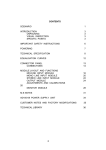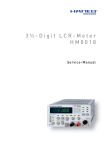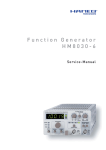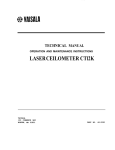Download AD161 User Manual
Transcript
CONTENTS 1 INTRODUCTION – READ ME!! ....................................................................... 1 Unpacking ........................................................................................................1 Visual Inspection .............................................................................................. 1 Specific Points – READ ME! ............................................................................ 1 2 IMPORTANT SAFETY INSTRUCTIONS – READ ME!! ................................. 2 3 POWERING ..................................................................................................... 3 4 TECHNICAL SPECIFICATION ....................................................................... 5 Electrical........................................................................................................... 5 Mechanical....................................................................................................... 6 5 HPF CURVES .................................................................................................. 7 6 BLOCK DIAGRAM ........................................................................................... 8 7 INPUT PANEL LAYOUT .................................................................................. 9 Input Panel Details .........................................................................................10 8 TOP PANEL LAYOUT....................................................................................11 Top Panel Details........................................................................................... 12 Output Panel Details ......................................................................................15 10 ADJUSTMENTS AND CALIBRATIONS....................................................... 16 Meter Calibration ............................................................................................16 PPM meter ..................................................................................................... 16 Line-Up-Tone Oscillator .................................................................................16 Low-Battery Indicator ..................................................................................... 16 Output limiter.................................................................................................. 17 Internal Settings (62-016-020)........................................................................17 Internal Settings (62-016-021)........................................................................18 11 POWER SUPPLY UNIT .................................................................................19 12 CUSTOMER NOTES AND FACTORY MODIFICATION............................20 14 TECHNICAL LIBRARY.................................................................................. 21 1 INTRODUCTION – READ ME!! Unpacking If there are any signs of damage to the outside of the carton, please notify us or your supplier immediately, regardless of the unit's apparent physical condition. This is in case a claim has to be made at a later date because of previously undetected transit damage. The packaging material should not be discarded until the mixer has been acceptance tested and a suitable transit/storage case is available for secure, safe storage. Visual Inspection Identification - please make a separate note of the serial number for your own capital equipment records. Ensure that it agrees with the number on the invoice/packing note. The serial number label is on the output panel. Temperature - check the meter glasses for condensation. If the package has been in transit during cold weather, leave the mixer for at least 12 hours to allow it to return to normal room temperature. Any measurements or subjective tests then made, will be to a known temperature reference. Specific Points – READ ME! Battery compartment - the mixer has an integral battery compartment to accept 6 AA cells. – Do not allow batteries to run below 1.0V per cell as this will degrade the performance of the mixer. Access to internally assignable DIL switches requires the removal of the bottom panel and side covers. Testing and calibration should only be undertaken by suitably qualified engineers. If in doubt contact the factory or your agent for advice. To protect the mixer and internal power supply an automatic reset fuse is mounted on the main printed board (62-016-020). Should a fault condition arise the link will reset when the reason for the fault has been removed. Limiter threshold - is set at the factory at +8dBu, but an internal preset potentiometer allows adjustment to any other level above 0dBu. Microphone powering - the mixer will remain unconditionally stable if the powering on unterminated input channels is switched off - this also improves the noise performance and crosstalk. Powering - 48V phantom (PH) or 12V tonader (TA) may be selected before or after the microphone is connected to the module. We wish you many trouble-free hours of use from your mixer. As a company, we are fully committed to BS EN ISO 9001. Should you have any problems or require any further information please do not hesitate to contact us. 1 WARNING! 2 IMPORTANT SAFETY INSTRUCTIONS – READ ME!! The user of electrical products must be familiar with their potential dangers, and fundamental precautions must always be taken. Please read the following text carefully. Power supply units manufactured by Audio Developments Ltd are not user serviceable. There are no user-serviceable parts associated with any such power supply unit. THE OUTER COVERS MUST NOT BE REMOVED! Such a power supply unit is solely for use with audio mixers and sound processors hereafter called the equipment - manufactured by Audio Developments Ltd. Always use a cord set accepted by a National Approved Body. EARTHING/GROUNDING: When using an external power supply unit that is connected to the mains supply to drive the mixer it must be CONNECTED TO EARTH. In certain types of malfunction or breakdown, earthing provides a path of least resistance for electric current and considerably reduces the risk of electric shock. DANGER: Incorrect connection of the equipment grounding/earthing conductor can result in the risk of electric shock. Where possible obtain a pre-wired mains lead from a reputable supplier with the correctly fitted mains connector for the type of mains outlet in use; otherwise, one correctly wired and checked by a qualified electrical engineer. If your mains lead is not suitable for the mains outlet, have the correct plug fitted by qualified personnel. The MAINS PLUG of this equipment is the primary disconnect device. Therefore, in the final application, ensure it remains close to the equipment and easily accessible. 2 3 POWERING The mixer may be powered from either internal cells or an external DC power source. The integral battery compartment requires a total of 6 AA cells. Access is gained via a captive lid which is retained by a 90 degree turn fastener. The lid hinges outwards from the side panel. Either conventional dry, or rechargeable cells may be used. Ensure correct cell rotation when populating the battery compartment. Note! There is no internal charge facility on the AD161. When driving the mixer from an external power source, PIN 1 is the 0V connection and a voltage in the range +9V to +15V DC should be supplied to PIN 4. The power source should be capable of delivering approximately 250mA - allowing some capacity for phantom powering. If an external power supply unit (PSU) is to drive the mixer, a current capability of at least 250mA is required. It is poor practice to run a PSU at its limit, therefore we recommend a minimum of 500mA. Audio Developments AD100-09 PSU is a suitable unit. WARNING: When NOT using the PSU (AD100-09) supplied for the mixer, ensure your 4-pin XLR is correctly wired to match the POWER IN connector. Failure to do so may result in the breakdown of the internal DC-DC converter. Make this check even if using a PSU which may have been supplied to you in the past, eg AD100-06 or AD100-05. NOTE:- No facility for charging nickel-cadmium cells exists within the AD161 Mixer. If these type of cells are used they must be recharged using a separate unit outside the battery box housing of the mixer. 3 THIS PAGE IS BLANK 4 4 TECHNICAL SPECIFICATION Electrical REFERENCE 0dB=775mV at 1kHz unless otherwise stated. GAIN MIC MAX INPUT LEVEL MIC @ MIN GAIN RETURN AUX INPUT -4dBu +18dBu +18dBu INPUT IMPEDANCE MIC RETURN AUX INPUT >2k5R >10kR >100kR MIC POWERING 48V PHANTOM & 12V TONADER MAX OUTPUT +23dBm +18dBm TRANSFORMER BAL (600R LOAD) H’PHONE MONITOR (600R LOAD) OUTPUT IMPEDANCE <60R <20R MAIN MONITOR 1 & 2 FREQUENCY RESPONSE 0: -1dB 0: -1.5dB MAIN OUTPUT MONITOR PATHS HARMONIC DISTORTION <0.05% @ 1kHz @ 0dBm OUTPUT <0.20% @ 50Hz to 15kHz @ +15dBm OUTPUT CROSSTALK <-65dB 40Hz to 15kHz INTERCHANNEL NOISE MIC <-125dB EIN 20Hz to 20kHz; 200R SOURCE HIGH PASS FILTER HPF: PRE-TRANSFORMER -3dB @ 150Hz -3dB @ 90Hz OUTPUT LIMITER THRESHOLD +8dB RATIO 10:1 ATTACK (FACTORY SET): RELEASE (FACTORY SET): CURRENT CONSUMPTION 75dB (continuously variable) 60dB (continuously variable) 12dB/OCTAVE 1.0Ms 250Ms 80mA FROM 12V DC SUPPLY (WITHOUT POWERED MICS) 5 Mechanical SIZE (CASE) 180mm X 146mm X 58mm SIZE (O/A) 205mm X 168mm X 64mm WEIGHT 1.15kg – INC. BATTERIES 6 5 HPF CURVES 7 6 BLOCK DIAGRAM 8 7 INPUT PANEL LAYOUT AD161 OFF PH TA (1) Microphone power 3 CH2 OFF Ø1 Ø2 PH TA (2) Input 2 phase reverse (4) Electronic balanced input XLR 2 OFF PH TA 1 POWER OFF ON (3) Mixer off/on switch (5) Battery compartment 6 X AA Cells 9 Input Panel Details Input XLR connector (4) accepts balanced microphone level signals. XLR (input & output) Pin 1 Pin 2 Pin 3 Shield Signal + Signal - In the case of unbalanced signals, pins 1 & 3 should be connected together. This will not lead to a loss of signal level. The microphone input functions are as follows: Switch (1) selects 48V phantom and 12V tonader power for use with condenser microphones. Powering may be selected before or after connecting the microphone, but switch off all powering on unterminated modules to ensure unconditional stability of the mixer. Input 2 has a phase change (2) which operates on the input signal. is the normal position. A two-position toggle switch (3) turns the mixer OFF/ON and any auxiliary equipment powered via the MULTIWAY connector. It selects either internal batteries or an external DC source. When external power is applied it takes precedence over the internal batteries. Power to the mixer is confirmed by the MIX ON LED. The internal battery compartment (5) requires a total of 6 AA cells. Access is gained via a captive lid which is retained by one 90 degree turn fastener. The lid hinges outwards from the side panel. 10 TOP PANEL LAYOUT 1K SLATE -18 (13) Aux to output AUX AUX (12) Slate mic inject 10 PFL 0 -75 0 (11) 1kHz tone inject (14) Monitor select LIM 10 (4) Limiter selector & threshold indicator OP MON1 RET (3) Slate level control TALK SLATE -24 -30 (2) Talk to monitor 2 (10) Mixer ‘on’ indicator -75 90 3 -60 150 0 (5) Output level control (15) Monitor 1 level control OFF -12 T EST 6 (1) Meter - PPM/VU BAT T 0 +3 BATT (9) Battery status OUTPUT OFF (16) High pass filter 11 150 90 1 (8) Input level control GAIN -60 0 (7) Input attenuator OFF PFL -75 90 2 -60 150 0 PFL (6) Internal microphone 8 (17) Pre-fade listen select Top Panel Details The input gain of the microphone amplifier is set by the 2-position switch (7). The maximum gain is either 60dB or 70dB determined by the position selected. Input level is controlled using the INPUT LEVEL control (8). The control acts on the microphone pre-amplifier gain and also performs the function of a conventional fader. This facilitates the maximum input signal capability increasing when the signal level/gain is reduced. The high-pass filter (16) operates on both input level settings. When selected the filter protects the input circuit from the effects caused by wind, traffic, air conditioning etc. Operating frequencies are to be found in the TECHNICAL SPECIFICATION. A fourth input at line-level is possible using the auxiliary input. The signal is routed to the main output by selecting the auxiliary routing switch; AUX (13). The level is controlled by a preset potentiometer mounted adjacent to the to the auxiliary input connector. (Mounted on the output panel). The OUTPUT LEVEL control (5) is the master, controlling the level of any signal mixed onto the main buss and determines the signal level at the main output. The limiter may be switched in to the main output - LIM (4). A red LED indicates when limiting is taking place. The threshold of the limiter (the signal level at which the limiter starts to operate) is factory set at an output signal level of +8dBu. Refer to the Adjustments and Calibrations section for the procedure on how to adjust the threshold level; if required. The 1kHz line-up tone, when selected (11), replaces the normal signal on the main output. Line-up tone is calibrated on the PPM scale to -6, giving a line-output level of 0dBu with the output fader (5) set to maximum. The calibration when a VU meter is fitted is an output level of +4dBu (0VU). The signal from the internal microphone (6) allows the mixer operator to add a voice signal to the main output by operating the switch marked SLATE (12) - the level being set by a screwdriver operated preset level control (3). TALK (2) enables the mixer operator to communicate with an outstation via Monitor 2. The signal replaces any other appearing at the outstation. The meter (1) is factory set to read main output. Alternatively it may be set to follow MON 1 switch (14) to read either main output, monitor output or aux input. This is determined by a DIL switch mounted on printed circuit 62-016-020 (Refer to Adjustments and Calibrations). The main output signal is metered and monitored after the output fader and limiter. The monitor signal is metered before its level control. Please refer to the Adjustments & Calibrations section for setting instructions. 12 Battery status is read on the meter (1) by selecting BATT (9). When a VU meter is fitted the 0VU mark indicates minimum battery volts. When the internal voltage drops below a safe operating level, the MIX ON indicator LED (10) will flash. The remaining controls are associated with headphone monitoring at monitor 1. Output (OP), tape-return (RET) or Auxiliary (AUX) may be selected (14): these signals are also available at Monitor 2. The level of Monitor 1 signal is controlled by potentiometer (15). Pre-fader listen (17) routes input signals to the monitor/PFL mix buss for auditioning on headphones and overrides the main monitor signal at Monitor 1. Caution - Care should be taken when operating the PFL if a high signal level is being fed into an input. This is because, under these conditions, an high signal level could then be present at the pre-fade point and if routed to the headphones would create a high pressure level, causing pain to the ears. 13 (4) Output XLR transformer balanced POWER IN Tel: 44(0)1543 375351 Fax: 44(0)1543 361051 email: [email protected] Serial Number 14 H I LO Made in England by Audio Developments Ltd., Hall Lane, Walsall Wood, Walsall, WS9 9AU. OUTP UT (3) Auxiliary input & level control RET 1 (2) Monitor 2 output & level control (5) External power connector (6) Return level control MULTIWAY (1) Monitor 1 output 2 1 2 3 4 0V NC NC 6-15V DC 1 2 3 4 5 6 OUTPUT MULTIWAY RETURN+ RETURN+12V OUT OUTPUT+ OUT PUTOV OUTPUT PANEL LAYOUT AU X 9 (7) Output & return multiway (8) Output level attenuator Output Panel Details Main output, XLR (4), is transformer balanced, and may be switched between microphone-level and line-level (8). Main output is also available at the MULTIWAY connector (7) and can be set internally using DIL 5 to follow or bypass the output attenuator (8). The factory setting is line level. Output XLR Pin 1 Pin 2 Pin 3 Shield Signal + Signal - The electronically-balanced tape-return enters the mixer on the MULTIWAY connector (7). Adjacent is the return input calibration preset (6). MULTIWAY Pin 1 Return + Pin 2 Return – Pin 3 Volts out Pin 4 Output + Pin 5 Output Pin 6 OV The headphone monitor 1 output appears on an ‘A’ type stereo jack (1). The monitor may be configured internally to allow either the main monitor signal (OP, RET or AUX) on both sides of the headphones or alternatively the main monitor signal on the left earpiece and AUX input (3) on the right earpiece. This latter configuration can be set by DIL 2 and DIL 4. Refer to Adjustments and Calibrations The headphone monitor 2 output appears on an ‘A’ type stereo jack (2). Level is set using the associated preset control. The monitor may be configured internally using DIL 3 to monitor either the main monitor signal (OP, RET or AUX) or the signal from input 1. This enables, for example, an outstation to receive only the signal from the boom microphone if feeding input 1. Selecting TALK overrides the monitor signal allowing the mixer operator to communicate with an external station. The electronically balanced AUX input enters the mixer on an ‘A’ type stereo jack (3). The level of signal is set using the associated preset control. The AUX can also be used as a fourth input allowing a line level signal to be routed to the main output. It also appears in the monitor section and can be used as a second return or communication input; when operated in conjunction with the TALK facilitates a twoway conversation between mixer operator and external station. External power is supplied to the mixer via the 4 pin male XLR (5). Refer to powering section for details. Power XLR Pin 1 Pin 2 Pin 3 Pin 4 0V N/C N/C 9V to15V DC 15 10 ADJUSTMENTS AND CALIBRATIONS Meter Calibration The meter - either VU or a PPM type may be selected. VU meter There is one preset (VR1), on PCB 62-016-022, for meter adjustment. Introduce a 1kHz tone from a signal generator to an input. Adjust levels to achieve a reading of +4dBu at the main output, on an AC millivoltmeter - measured across pins 2 and 3 of the output XLR. Ensure that the meter mechanical zero is set then adjust VR1 preset to give a meter reading of 0VU. PPM meter The PPM driver printed circuit (62-016-023) has three calibration controls (presets). VR1 adjusts the reference level, VR2 and VR3 adjust the 'law' of the meter. VR2 adjusts the upper sector of the scale and VR3 adjusts the lower sector. To initiate calibration, set each preset to its mid position. Using the tone generator and millivoltmeter as described above, adjust mixer levels for a reading of -6dBu, on the millivoltmeter, from the main output. Adjust VR1 for reading of -12. Increase the output signal to +6dBu and adjust VR2 for a reading of 0. Decrease the output signal to -18dBu and adjust VR3 for a reading of -24. Repeat this procedure until an accurate set of readings is obtained without further adjustment to any of the presets being required. Now check the calibration of all meter points. Line-Up-Tone Oscillator To adjust tone level at the output of the mixer apply an AC millivoltmeter across pins 2 & 3 on the output XLR and adjust preset VR3 (mounted on printed circuit board 62016-020) to achieve the desired reading. Factory settings - 0dBu when PPM meter fitted; +4dBu when VU fitted. Low-Battery Indicator The low reading is set at the factory and corresponds to a set of batteries having discharged to 1 volt/cell. On a VU meter, low volts is at 0VU. On a PPM meter it is indicated by a separate marking. To set apply 6.7v to pin 4 of the external power connector and adjust VR106 (located on PCB 62-016-021) and align meter pointer to the appropriate mark. 16 Output limiter Biasing and threshold are adjusted as follows: VR109 biases the limiter circuit to the point of correct operation and VR108 sets the threshold. (Labelled SET 0 and THR respectively.) With no signal present, VR109 should be adjusted to give a reading in the range -1.5V to -2.5V at PIN 7 of IC 105. VR108 should be adjusted to give a reading in the range -2.5V to -3.5V at PIN 3 of IC105. Apply a signal at 1kHz to the mixer to give a level of 0dBu at the main output. Then select the limiter function and adjust VR109 until the output signal starts to fall (typically 0.2dB). The DC voltage at PIN 7 of IC 105 should be approximately -2.0V. After setting VR109, adjust the output signal to just greater than +8dBu with the limiter deselected. Introduce the limiter and adjust VR108 until the output signal falls to +8dBu. This is the THRESHOLD setting. (If a different threshold setting is required, alter the signal levels accordingly.) The DC voltage at PIN 3 of IC 105 should be approximately 0.6V different from that at PIN 7. Internal Settings (62-016-020) DIL 2 VR4 PRE HI LO POST HI LO DIL 1 MON OUTPUT VR3 17 Internal Settings (62-016-021) DIL 101 HP 1 L a b o n HP 2 R VR106 SET LOW BATTERY VR108 THR VR109 SET 0 DIL 102 AUX CH1 RET HP1 a b 18 11 POWER SUPPLY UNIT TYPE AD100-09 The AD100-09 mains POWER SUPPLY UNIT is suitable for driving most of AUDIO DEVELOPMENTS’ range of portable audio mixers. This PSU is a single-rail device providing 500mA of current at +14V DC potential and is used as a substitute for battery power with mixers containing an internal DC-DC converter. The AD100-09 may be powered from either a 110V/120V AC source or a 220V/240V AC source. Ensure that the AC Voltage Selector Switch on the front panel is in the correct position for the source in use. Operating the equipment at the wrong voltage could be hazardous. Care must be taken to connect the LIVE, NEUTRAL and EARTH pins of the PSU’s IEC mains connector to the corresponding terminals associated with the AC source. The ON/OFF switch contains an indicator that illuminates when the PSU is operational. FOR SAFETY REASONS, AD100-09 POWER SUPPLY UNIT MUST BE CONNECTED TO MAINS EARTH. Any maintenance to the PSU or its mains cable assembly should be performed by a qualified engineer. CHARGING: If nickel-cadmium cells are fitted in an AD140 series mixer, they may be recharged in situ from AD100-09 power supply - whether the mixer is in use or not. (Maximum current is set at 250mA - in addition to the 500mA of current supplying the audio electronics.) The charging circuit has its own ON/OFF slide switch and LED indicator. DO NOT ACTIVATE THE CHARGE CIRCUIT UNLESS THE MIXER IS FITTED WITH NICKEL-CADMIUM CELLS. FUSES: Two 20mm ANTI-SURGE fuses protect AD100-09 against fault conditions. Should either fail, it is strongly recommended that the cause be traced. Refer to the TECHNICAL LIBRARY. Only suitably qualified personnel should service the power supply unit. The fuse holder on the front panel contains the mains fuse. 250mA HRC TYPE T 240v AC For continued safety the specified fuse link must be fitted in the mains fuse holder when a replacement is required. Ensure it is of a type approved by a National Approved Body. DC-OUTPUT XLR PIN 1 PIN 2 OV CHARGE PIN 3 PIN 4 NOT CONNECTED +14V DC DO NOT REMOVE THE OUTER COVERS NOTE: The power supply unit should be serviced by a suitably qualified engineer. Only genuine spare parts with identical specification must be used. It is DANGEROUS to change the specification or modify the product in any way. 19 12 CUSTOMER NOTES AND FACTORY MODIFICATION 20 14 TECHNICAL LIBRARY 21







































